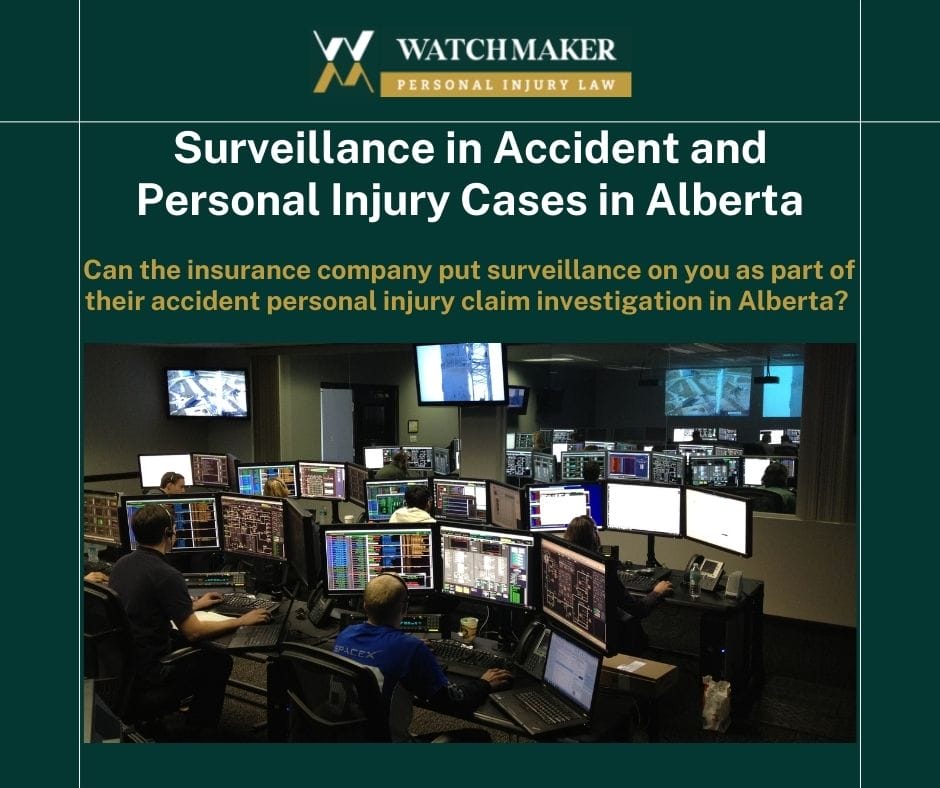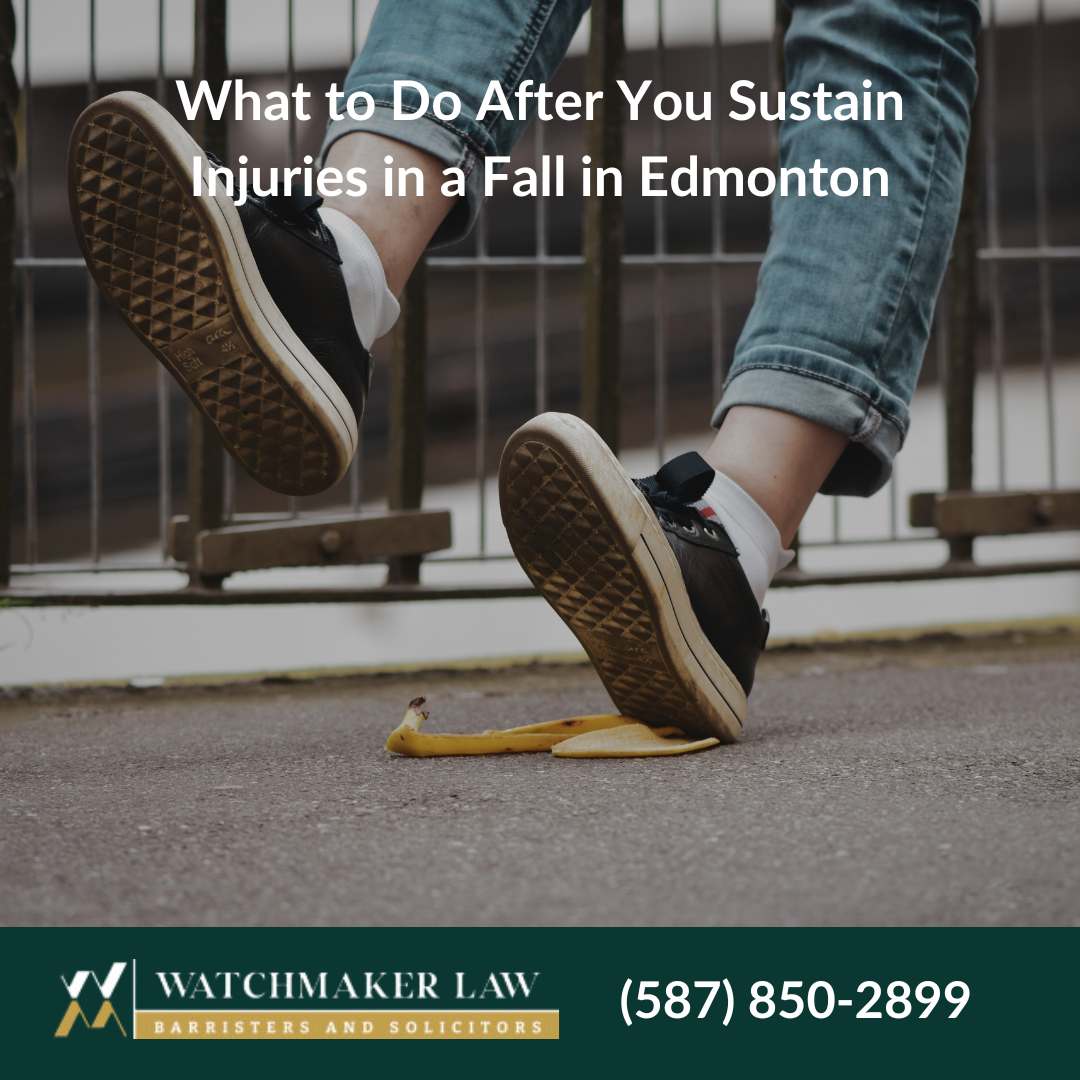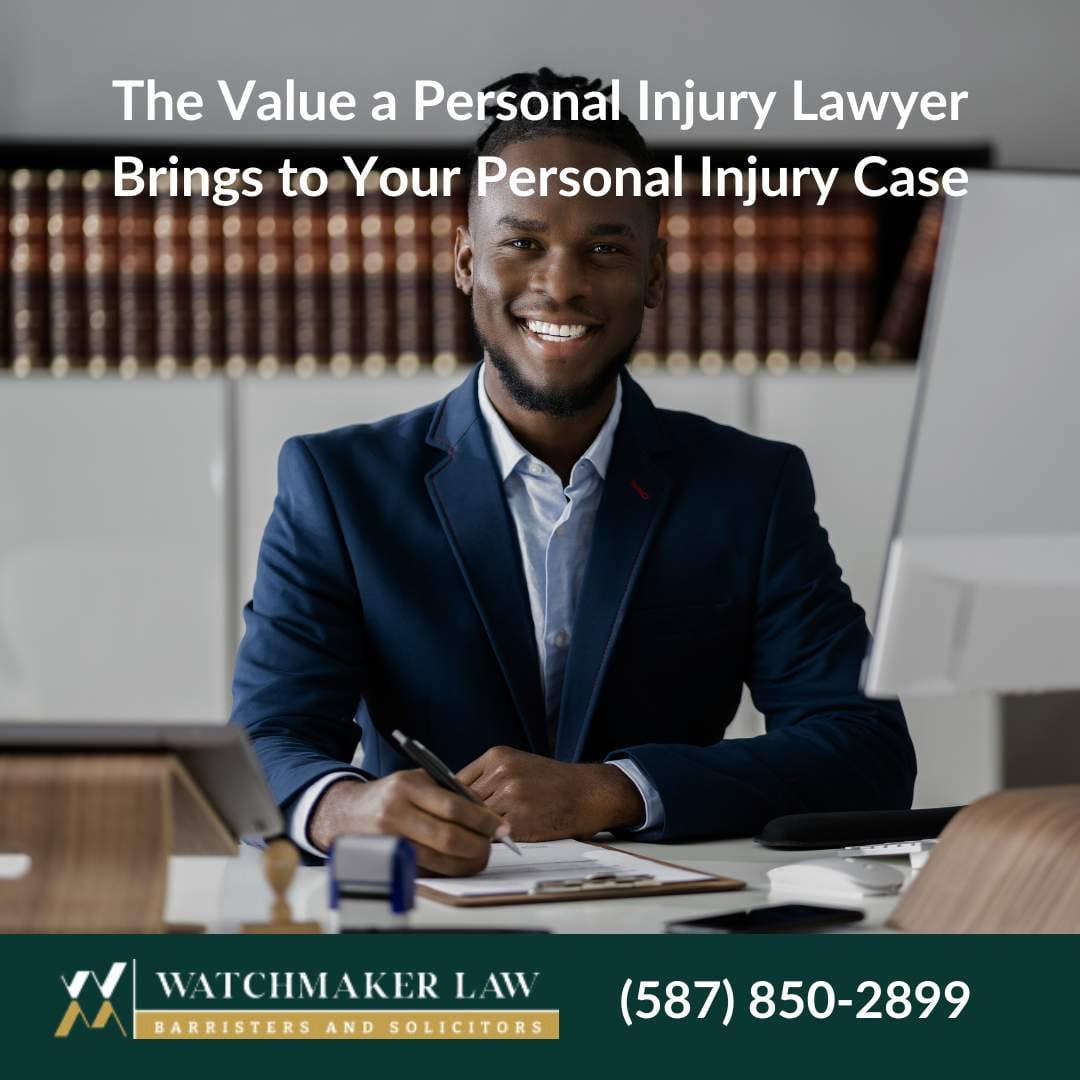Surveillance in Personal Injury Cases
Can the insurance company put surveillance on you as part of their accident personal injury claim investigation in Alberta?
Introduction:
If you have sustained personal injuries in a motor vehicle accident in Edmonton and other areas in Alberta, you may have heard that insurance companies deploy private investigators to record your activities in an attempt to catch you in a lie as regards the personal injuries you are alleging to have sustained as a result of a motor vehicle accident in Edmonton and other areas in Alberta. In this blog we take a look at the reasons insurance companies give for gathering surveillance evidence of injured persons who have sustained personal injuries. We then discuss the two types of surveillances and the current trend towards social media surveillance. I review three cases that show how courts have handled surveillance evidence in the past at personal injury trials.
Ultimately, being honest and forthright with the medical professionals that you see in relation to your accident related personal injuries is always a good starting point to negate any surveillance evidence that is obtained. However, as the review of the accident and personal injury cases below will show you, it is not always as clear cut as being honest, sometimes, surveillance video evidence may be taken completely out of context if effort is not made by an experienced accident and personal injury lawyer to safeguard the appropriate use of the surveillance evidence. Surveillance videos are regularly entered into evidence during personal injury cases as long as the normal rules of admission of evidence are followed. Gathering of surveillance evidence is permitted as long as it is obtained while you are in a public space, but the use of the surveillance evidence can be curtailed by using legal principles that your experienced personal injury lawyer can explain to you.

Why Do Insurance companies do surveillance?
One of the primary reasons why insurance companies use surveillance evidence is to call your credibility into question. Accident and personal injury lawyers call this process “credibility impeachment”. All this means for the layman is that they are looking for ways to call your subjective evidence about accident related personal injuries into question. To further explain this, throughout the duration of your claims, you would have attended treatments and medical assessments. At these medical assessments and treatments, you would have provided subjective account of your injuries and ongoing symptoms. One of the common ways that insurance companies challenge these subjective accounts of your injuries is to obtain surveillance evidence that would discredit the subjective evidence of your accident and personal injury claims. The surveillance evidence could be obtained in person or through social media.
Types of surveillance evidence in your motor vehicle accident personal injury case:
(In-person and social media).
Based on my experience as an insurance adjuster before going on to pursue a career in law, I can tell you that insurance companies used to prefer in person surveillance where they would physically follow injured claimants around in public spaces to record them performing activities that call their credibility and subjective complaints into question. The second and the more prominent way that insurance companies gather surveillance in recent years is by simply gathering information posted on an injured claimant’s social media profile on platforms like Facebook, Twitter X, Instagram and Tik Tok.
Below in the next section below, I provide a breakdown of the pros and cons of in-person and social media surveillance. By knowing the pros and cons of both methods, you can have a better understanding of why the insurance company might choose one over the other in your personal injury case in Edmonton and across Alberta.
Advantages of In-person surveillance for insurance companies.
An insurance company might still prefer in-person surveillance in 2024-2025 for the following reasons:
- Tailored surveillance: Insurance companies can tailor the in-person surveillance to the specific issues in the personal injury case: They could give specific instructions to the private investigator to pay attention to certain physical activities that you say you are not able to perform.
- Incidental finding: Aside from getting access to evidence that are specific to the issues in the personal injury case, the insurance company can also find other evidence that could relate to another issue in the case that is not directly related to the initial issues that the surveillance sought out to find. For example, they can discover that you don’t use your seat belt regularly.
Disadvantages of In-person Surveillance for insurance companies:
- Expensive: Insurance companies can spend thousands and thousands of dollars to monitor the activities of people who are claiming personal injuries after a motor vehicle accident. This can be costly relative to its advantages.
- Large unused and wasted footage/data: Due to the nature of in-person surveillance evidence gathering, the private investigator and their insurance company client can end up with huge amount of footages and data sometimes of mundane and irrelevant activities that do not add any value to the case or the issues that have been identified as the main reasons for the surveillance in the first place.
- Mistaken identity: I have seen a case before where the private investigator hired by the insurance company completely mistook the plaintiff for someone else. This can lead to obvious issues and will not have the intended benefit for the company.
Pros of Social Media Surveillance.
On the other hand, an insurance company may prefer social media surveillance instead for the following reasons:
- Cost effective: One of the key advantages of social media surveillance over in-person surveillance is the fact that insurance companies may not need to spend thousands of dollars to hire a private investigator to follow a personal injury claimant around for weeks, sometimes months.
- Incidental findings: The same advantage that applies above also applies to the social media generated surveillance evidence. As people continue to post multiple portions of their lives on social media platforms, insurance companies may figure out where the claimant vacations, their social and personal affiliations and whether the claimant is working or not.
Cons of social media surveillance:
- Controlled content: It is now an open secret that insurance companies perform surveillance on individuals who have suffered personal injuries as a result of a motor vehicle accident in Edmonton and across Alberta. This means that the claimant can and will in many cases make several changes to their social media privacy settings to ensure the insurance company only sees what they want them to see. This might not be an effective method for the insurance company to gather objective evidence.
- Mistaken identity: This limitation is not only limited to in-person surveillance, it can be very pronounced as well on social media surveillance evidence gathering. People use different names on their social media profiles and there are several privacy settings that can be deployed to hide someone’s identity online that could lead an adjuster to not land on the profile of the individual that they are looking for.
Some Accident and Personal Injury Court Decisions Involving the use of Surveillance…
Below are three examples of how Alberta Courts in previous cases have used or relied on
- Unreliable Witness: Surveillance evidence regardless of how they are obtained can be used to call the reliability of your evidence into question. Let us put this into some context: It is noteworthy that the cases that end up in trial end up in trial after several years of going through the steps in the litigation process. The steps will most likely include medical assessments, treatments, questionings on undertakings and so on. In addition to the steps already mentioned, you, as the claimant in the personal injury case may have provided several written and verbal recorded statements to third parties like the police, emergency first responders, disability insurance companies and/or lay witnesses. Any of these third parties can be called to trial as witnesses to address one or two issues at-issue at the trial. The statements may contain subjective accounts of your experiences, disability and symptoms in relation to your pain and other allegations you are making in relation to the motor vehicle accident injuries you are claiming. Now, this is where the surveillance evidence gathered by the insurance company can be used to call the previous statements that you have made into question and to determine whether they are reliable.
In the Alberta accident case, Minhas v. Hayden, we see a good example of how the court used surveillance evidence to call the reliability of the plaintiff into question. In this case, the insurance company had the plaintiff under surveillance over a long stretch of time, intermittently, from March 2003 to December 28, 2011. Trial was held on April 16, 2012. The motor vehicle accident happened on February 9, 2003. At trial, the court found that the plaintiff was not a reliable witness, specifically due to the lack of consistency in his reports to the medical professionals that he had seen and on the one hand and the apparent evidence as portrayed in the surveillance evidence that he was confronted with at trial. The court commented that the surveillance video made it clear that he continues to have mobility that he has told the various professionals who have attended upon him since the accident in 2003. The plaintiff tried explaining the surveillance evidence away by arguing that his pain levels fluctuated but the court did not buy this explanation. Ultimately, the court went on to award $60,000 in general damages.
How to guard against the risk of your evidence being called unreliable in your motor vehicle accident personal injury case:
- Do not exaggerate or downplay your symptoms: There is simply no need to exaggerate your symptoms or disability. Just be candid and forthright as regards your disability and what you are going through. This also applies to downplaying or undermining what you are going through for whatever reason. Present your statement to relevant authorities as you actually experience them. My experience is that most claimants are honest and not out to get one over anyone. So, let that shine through your accounts of your pain and experiences following a motor vehicle accident in Edmonton and other areas in Alberta.
- Keep your accounts and statements consistent: Try to the best of your knowledge to keep your accounts consistent as much as possible. It is generally okay to keep notes of accident-related information to ensure you don’t miss or forget key details of your accounts and description of the accident information. Just keep in mind that you may need to subsequently produce these notes as part of the personal injury case. But it might also help you to refresh your memory during the personal injury case. Remember that many of these motor vehicle personal injury cases take time to get to trial, sometimes, they could take several years.
Credibility impeachment: This simply means they can use surveillance evidence obtained to call your credibility into question. This is what lawyers call impeaching a witness’s credibility. We see this use at play in the Alberta case known as Sluth v. Kostyniuk 917, the defendant hired a private investigator to gather video evidence of the plaintiff. The video evidence was gathered over a long period of time. 88 minutes of the videos were played in court. The video segment played in court showed the plaintiff working laying sod, including many examples of the plaintiff doing several of the following: pushing or pulling layers of sod into place with a rake; he was on his hands and knees laying and cutting sod all by hand, bending over at up to 90% from the waist and picking up, carrying, and laying and down up to 2 rolls of sod at a time ; picking up sod scarps and putting them into a plastic wheel barrow and wheeling the wheel barrow full of such scraps up to chest height and dumping it; picking up and carrying a wooden pallet over his head and throwing it down; and on one occasion, standing on the tailgate of a ½ ton truck and reaching over and picking a metal 3 wheeled wheelbarrow off the ground and placing it in the truck.
There was further admission that there were more videos showing him operating machinery and directing other employees. In short, the videos showed him performing very hard labour without apparent indication of pain, difficulty or discomfort in his work. The court also found that he was working energetically at a very fast pace and seemingly without undue effort. The court found that the video evidence puts “his subjective comments of constant pain into question”.
In this case as well, the plaintiff tried to explain the video away by arguing that he simply worked through the pain. Ultimately, the court accepted that the video indeed impeached his credibility on the issue of constant pain and contradicted his expert’s whole person impairment of 6% whole body impairment. The court considered the law, the evidence and the plaintiff’s credibility and ultimately concluded awarded a general damage of $40,000.00
Ensuring the credibility of your evidence
- The same information regarding how to safeguard the reliability of your evidence also applies to ensuring it is perceived as credible. Do not exaggerate your symptoms and also keep a record of your accounts to ensure you can refresh your memory as your case proceeds through the litigation process.
- Trust the legal process to safeguard and deliver fairness for your case. This is important because if you do and hire an experienced accident personal injury lawyer, you will not feel pressured to advocate for yourself. Advocating for yourself might affect how composed you are when giving your accounts of your symptoms and other motor vehicle accident details. Composure can affect how you are perceived throughout the process.
- Maintain composure: Closely related to the above point is that you should always maintain your composure when presenting your symptoms to insurance company adjusters, medical professionals and the court. How composed you can be used to determine how credible your accounts are.
Surveillance can be used to limit your Personal Injury Compensation:
An example of a case where surveillance evidence was used to successfully limit the accident personal injury claim is the Bumstead v. Dufresne case. In this personal injury case, the plaintiff made a personal injury claim following a motor vehicle accident case where he had been rear-ended. In addition to the motor vehicle personal injury claim, he also brought a long-term disability claim against his disability insurer.
As part of their investigation into the personal injury claims and disability of the plaintiff, the disability insurer placed the plaintiff under surveillance. While the surveillance covered an extended period of time, from December 2007 to July 2009, the most controversial surveillance footage was recorded on March 7th, 2008. The footage showed the plaintiff performing mechanical work on his vehicle for over three hours at once. The video showed him moving around his truck and in several positions, such as standing, kneeling, stooping and crouching down. He also did not appear in pain, working slowly or taking extended breaks. On the same day, the footage also showed him to be at the grocery store, reaching over the counter to grab items and walking out of the store at a fast pace with no signs of impairment.
The plaintiff in this case tried to argue the video footage away by stating that he had a “good day” on the March 7, 2008, footage that was reviewed by the court. The court did not buy it. In addition to the finding of credibility, the court also relied on the video to confirm that the plaintiff did not follow the medical instructions of his providers like not wearing his SI belt and Obusforme back rest while driving. All of these went to support the finding of the plaintiff’s lack of credibility. The court concluded that the plaintiff failed to establish on a balance of probabilities that he was fully disabled and unable to work due to the motor vehicle accident injuries beyond the date of the surveillance video of March 7, 2008. This case confirms the weight that the court can place on surveillance video to assess a plaintiff’s credibility as regards a motor vehicle accident personal injury case. The Bumstead’s decision was upheld at the Court of Appeal.
Surveillance can actually help your Accident and Personal Injury Claim: Lessons from Henhoeffer v. Liu.
There are situations where surveillance evidence obtained by the insurance company can help your accident and personal injury claim. Following all the helpful information in this blog above, surveillance evidence obtained by the insurance company can certainly end up being a blessing in disguise. In cases where you have consistently presented the accident details and injury symptoms in a candid and unexaggerated matter, you may find that surveillance evidence may not be the silver bullet that the insurance company is hoping it is for their case. This was the situation in the court case known as Henhoeffer v. Liu case. In that case, the court found that the video surveillance which was supposed to damage the plaintiff’s case in fact assisted in helping the plaintiff prove his injuries. In paragraph 49, the court noted that no significant weight will be ascribed to the video due to the “video being presented in an edited version which contained numerous breaks and the removal of certain portions”. Regardless of those technical issues, the court noted that the videos were not of any assistance in any event. The court concluded that the video in fact “demonstrated the support from the plaintiff’s evidence and that of other witnesses he called to show that he suffered the injuries he testified to and that the consequences that flowed therefrom”
The Henhoeffer case shows that surveillance video does not have to be the death verdict for your personal injury case. It could in some cases help your case if you have been candid with your medical professionals and have done the best you can to maintain the consistency of the evidence and other information that you have provided all through the course of the personal injury case and litigation.
WATCHMAKER LAW’S KEY TAKE AWAYS FOR HOW TO HANDLE SURVELLANCE VIDEOS OBTAINED AGAINST YOUR PERSONAL INJURY CASE:
- Present your personal injury symptoms honestly and consistently when presenting the details of the accident and especially the symptoms of your personal injury case.
- Ensure your accident and personal injury lawyer tests the authenticity and veracity of the surveillance video.
- Ensure you have reviewed the entirety of the evidence. The insurance company cannot simply pick and choose which footage that they want to rely on. You and your personal injury lawyer have the right to review the entirety of the video, not just handpicked portions of it.
- Retain an experienced personal injury lawyer to use the rules of evidence to restrict what the insurance company can use the surveillance video evidence for in your personal injury claim.
From all the information provided above, it is clear that this is another complicated area of personal injury law. If you are confronted with surveillance video evidence as part of your accident personal injury case, contact WATCHMAKER LAW today to get a free consultation about how we can assist you. Watchmakerlaw.com



